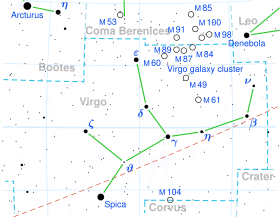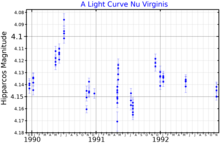
| |
| Observation data Epoch J2000.0 Equinox J2000.0 | |
|---|---|
| Constellation | Virgo |
| Right ascension | 11 45 51.5596 |
| Declination | +06° 31′ 45.749″ |
| Apparent magnitude (V) | 4.04 |
| Characteristics | |
| Evolutionary stage | asymptotic giant branch |
| Spectral type | M1 III |
| U−B color index | +1.80 |
| B−V color index | +1.52 |
| Astrometry | |
| Radial velocity (Rv) | 50.19±0.30 km/s |
| Proper motion (μ) | RA: −21.1 mas/yr Dec.: −182.9 mas/yr |
| Parallax (π) | 9.8446 ± 0.2744 mas |
| Distance | 331 ± 9 ly (102 ± 3 pc) |
| Absolute magnitude (MV) | −0.87 |
| Details | |
| Mass | 0.92±0.00 M☉ |
| Radius | 54.8±0.9 R☉ |
| Luminosity | 523±31 L☉ |
| Surface gravity (log g) | 1.0 cgs |
| Temperature | 3,728±47 K |
| Metallicity | −0.41 dex |
| Rotational velocity (v sin i) | 3.8 km/s |
| Age | 11.69±0.13 Gyr |
| Other designations | |
| ν Vir, 3 Virginis, BD+07°2479, FK5 1302, HD 102212, HIP 57380, HR 4517, SAO 119035 | |
| Database references | |
| SIMBAD | data |
ν Virginis, Latinized as Nu Virginis, is a single star in the zodiac constellation of Virgo, located at the western tip of the classic constellation and nearly due south of the prominent star Denebola. It is a red-hued star with an apparent visual magnitude of 4.04 and can be seen with the naked eye. Because the star lies near the ecliptic it is subject to occultations by the Moon. Parallax measurements provide an estimated distance of around 331 light years from the Sun, and it is drifting further away with a radial velocity of +50 km/s.

This object is an M-type red giant, currently on the asymptotic giant branch, with a stellar classification of M1 III. The star was discovered to be a variable star when the Hipparcos data was analyzed. It is an SRB-type semiregular variable star with its brightness varying by 0.0125 in magnitude. These variations have four periods lasting 11.1, 12.3, 16.8, and 23.7 days. This star has 90% the mass of the sun, but it has expanded to 54 times the Sun's radius and shines 520 times as brightly as the Sun. The effective temperature of its outer atmosphere is 3,728 K.
References
- ^ Vallenari, A.; et al. (Gaia collaboration) (2023). "Gaia Data Release 3. Summary of the content and survey properties". Astronomy and Astrophysics. 674: A1. arXiv:2208.00211. Bibcode:2023A&A...674A...1G. doi:10.1051/0004-6361/202243940. S2CID 244398875. Gaia DR3 record for this source at VizieR.
- ^ Mermilliod, J.-C. (1986), "Compilation of Eggen's UBV data, transformed to UBV (unpublished)", Catalogue of Eggen's UBV Data, SIMBAD, Bibcode:1986EgUBV........0M.
- ^ Eggen, Olin J. (July 1992), "Asymptotic giant branch stars near the sun", Astronomical Journal, 104 (1): 275–313, Bibcode:1992AJ....104..275E, doi:10.1086/116239.
- ^ Morgan, W. W.; Keenan, P. C. (1973), "Spectral Classification", Annual Review of Astronomy and Astrophysics, 11: 29–50, Bibcode:1973ARA&A..11...29M, doi:10.1146/annurev.aa.11.090173.000333.
- ^ Massarotti, Alessandro; et al. (January 2008), "Rotational and radial velocities for a sample of 761 HIPPARCOS giants and the role of binarity", The Astronomical Journal, 135 (1): 209–231, Bibcode:2008AJ....135..209M, doi:10.1088/0004-6256/135/1/209, S2CID 121883397.
- Pace, G.; et al. (April 2003), "The Wilson-Bappu effect: A tool to determine stellar distances", Astronomy and Astrophysics, 401 (3): 997–1007, arXiv:astro-ph/0301637, Bibcode:2003A&A...401..997P, doi:10.1051/0004-6361:20030163, S2CID 17029463.
- ^ Baines, Ellyn K.; Armstrong, J. Thomas; Schmitt, Henrique R.; Zavala, R. T.; Benson, James A.; Hutter, Donald J.; Tycner, Christopher; van Belle, Gerard T. (2017). "Fundamental parameters of 87 stars from the Navy Precision Optical Interferometer". The Astronomical Journal. 155 (1): 16. arXiv:1712.08109. Bibcode:2018AJ....155...30B. doi:10.3847/1538-3881/aa9d8b. S2CID 119427037.
- "* nu. Vir". SIMBAD. Centre de données astronomiques de Strasbourg. Retrieved 2016-09-08.
{{cite web}}: CS1 maint: postscript (link) - Eggleton, P. P.; Tokovinin, A. A. (September 2008), "A catalogue of multiplicity among bright stellar systems", Monthly Notices of the Royal Astronomical Society, 389 (2): 869–879, arXiv:0806.2878, Bibcode:2008MNRAS.389..869E, doi:10.1111/j.1365-2966.2008.13596.x, S2CID 14878976.
- Kaler, James B., "Nu Virginis", STARS, retrieved 2019-10-06.
- White, Nathaniel M.; Feierman, Barry H. (September 1987), "A Catalog of Stellar Angular Diameters Measured by Lunar Occultation", Astronomical Journal, 94: 751, Bibcode:1987AJ.....94..751W, doi:10.1086/114513.
- "/ftp/cats/more/HIP/cdroms/cats". Centre de Données astronomiques de Strasbourg. Strasbourg astronomical Data Center. Retrieved 15 October 2022.
- Kazarovets, E. V.; Samus, N. N.; Durlevich, O. V.; Frolov, M. S.; Antipin, S. V.; Kireeva, N. N.; Pastukhova, E. N. (January 1999). "The 74th Special Name-list of Variable Stars" (PDF). Information Bulletin on Variable Stars. 4659: 1–27. Bibcode:1999IBVS.4659....1K. Retrieved 14 December 2024.
- Kazarovets, E. V.; et al. (1999), "The 74th Special Name-list of Variable Stars", Information Bulletin on Variable Stars, 4659 (4659): 1, Bibcode:1999IBVS.4659....1K.
- Koen, Chris; Eyer, Laurent (March 2002). "New periodic variables from the Hipparcos epoch photometry". Monthly Notices of the Royal Astronomical Society. 331 (1): 45–59. arXiv:astro-ph/0112194. Bibcode:2002MNRAS.331...45K. doi:10.1046/j.1365-8711.2002.05150.x. S2CID 10505995.
- Tabur, V.; et al. (December 2009), "Long-term photometry and periods for 261 nearby pulsating M giants", Monthly Notices of the Royal Astronomical Society, 400 (4): 1945–1961, arXiv:0908.3228, Bibcode:2009MNRAS.400.1945T, doi:10.1111/j.1365-2966.2009.15588.x, S2CID 15358380.